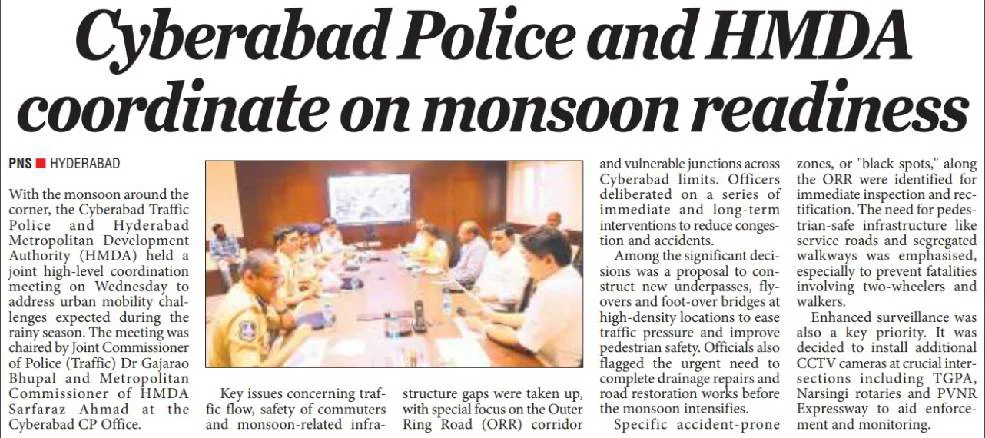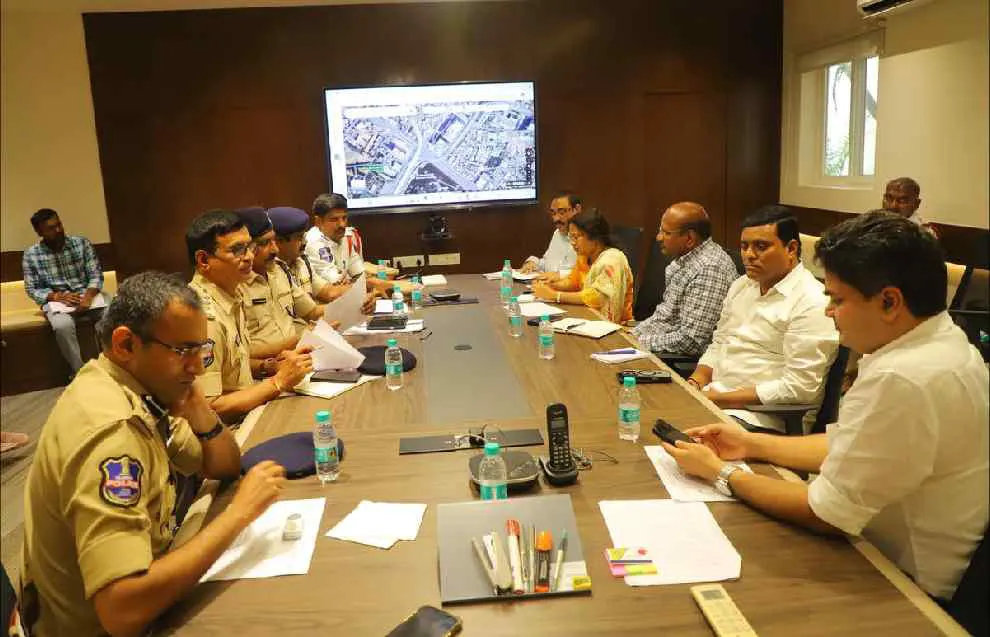As the monsoon looms, Cyberabad Traffic Police and the Hyderabad Metropolitan Development Authority (HMDA) have rolled out an ambitious, focused action plan to keep Hyderabad’s Outer Ring Road (ORR) corridor flowing smoothly. Driven by the leadership of Cyberabad Joint Commissioner of Police (Traffic) Gajarao Bhupal and HMDA Metropolitan Commissioner Sarfaraz Ahmad, the initiative aims to tackle monsoon-related hurdles head-on, prioritizing infrastructure safety and commuter comfort.
Let’s dive into the key areas of this action plan, how these efforts will impact daily life, and what the city’s residents can expect this monsoon.

Construction of Underpasses and Foot-Over Bridges for Enhanced Safety:
The monsoon brings not just relief from the summer heat but also poses serious challenges for road safety, especially for pedestrians and vulnerable commuters like two-wheeler riders. Recognizing this, the authorities have identified critical junctions across the ORR that demand immediate intervention.
- Identified Key Junctions: Narsingi rotary, PVNR Expressway, and TGPA have been prioritized due to their accident-prone nature.
- Community Benefit: These new pathways will give peace of mind to those who currently dodge traffic, making a simple walk to a bus stop or shop far safer.
- Timeline: Work is set to commence in phases with a strong push to complete before the peak monsoon weeks.
The plan includes constructing much-needed underpasses and foot-over bridges at these high-traffic points. These structures aren’t just concrete and steel; they’re lifelines for the daily wage earners, students, and elderly residents who rely on safe passage. According to Sarfaraz Ahmad, these projects will reduce pedestrian fatalities and accidents that spike during the rains. This focus on pedestrian safety highlights a shift in how Hyderabad plans urban mobility, people first, vehicles second.
Resolving Traffic Issues: Clear Lanes for a Smooth Congestion
Let’s be honest traffic jams are more than a mild inconvenience; they’re a test of patience. With the monsoon magnifying these issues, the action plan zeroes in on eliminating traffic bottlenecks along the ORR, ensuring that rain-soaked roads remain navigable.
The Cyberabad police have already identified areas where narrow lanes and poor junction designs cause bottlenecks during normal conditions, which worsen during the rains. Here’s how they’re tackling it:
- Immediate Rectifications: Widening lanes, recalibrating traffic signals, and smoothing out abrupt curves that cause pile-ups.
- Emergency Response Readiness: Deployment of quick-response traffic units to manage congestion spikes, especially during heavy downpours.
- Targeted Locations: Critical pinch points like the ORR service lanes and main entry/exit ramps, where stagnant water and vehicle density collide.
These efforts are about more than just smoother drives; they’re about reclaiming precious hours lost to jams. Picture getting home to your family 30 minutes earlier because of these changes, it’s that kind of impact the plan hopes to deliver.
Strengthening Collaboration Between Cyberabad Police and HMDA Departments:
The monsoon action plan’s success hinges on strong coordination between various departments, a fact not lost on the Cyberabad police and HMDA leadership. During the meeting, the emphasis was placed on tearing down silos and working as a single unit to ensure seamless operations during heavy rains.

Gajarao Bhupal and Sarfaraz Ahmad highlighted that past monsoon challenges often arose because of gaps in communication between traffic police, road maintenance crews, and drainage repair teams. This year, they’re determined to change that narrative. By creating a central task force with representatives from each department, they’re fostering daily information sharing and joint problem-solving.
The idea is simple: a pothole reported by traffic police should trigger an instant repair alert to the HMDA team, not days of back-and-forth paperwork. Similarly, drainage blockages flagged by road engineers must be swiftly relayed to traffic control units to manage diversions and avoid accidents. This unified approach promises to cut through red tape and put Hyderabad’s commuters first, a refreshing change that many residents have long called for.
Upgrading Drainage and Service Roads: Fighting Waterlogging Head-On
Waterlogged streets are a familiar sight during Hyderabad’s monsoon, turning daily commutes into obstacle courses. The city’s planners aren’t ignoring this reality. The monsoon action plan prioritizes swift drainage upgrades and service road repairs that directly address this monsoon misery.
For starters, a comprehensive assessment of existing drains has been launched, pinpointing where clogged or damaged pipes need replacement. Sarfaraz Ahmad emphasized that a drainage system in good shape is the backbone of any monsoon-ready city. Alongside this, service roads along the ORR, often the first to flood, will see intensive patching and resurfacing to prevent pothole formation.
Points of focus include:
- Urgent Repairs: Clear out blocked drains, reinforce weak sections, and install new covers to prevent debris from causing blockages.
- Smooth Rides: Resurfacing service roads to ensure two-wheelers and cars don’t have to navigate craters of rainwater.
- Community Involvement: Local businesses and resident associations are also pitching in, reporting problem spots to accelerate the fixes.
These measures promise not just less water on the roads, but also fewer risks to life and property, making monsoon travel far less daunting.
Surveillance Expansion and Regular Reviews: Eyes on the Ground
Rainy days often bring reduced visibility, but that’s not stopping the city’s watchful eyes. An integral part of the monsoon action plan is expanding CCTV surveillance at high-risk intersections and ensuring real-time traffic monitoring.
- Boosting Safety: New cameras will help catch issues early, like stranded vehicles or sudden water build-ups, before they escalate.
- Regular Follow-Ups: Cyberabad police and HMDA will conduct weekly review meetings to track progress on these installations and fine-tune traffic management as needed.
- Enhanced Coordination: Live camera feeds will be integrated with emergency response teams, ensuring help reaches faster during monsoon crises.
In the meeting, it was decided to fast-track CCTV installations at pivotal points like the Narsingi rotaries and PVNR Expressway, places known for tricky traffic patterns that become even more dangerous in the rain. For Hyderabad’s drivers and commuters, this means a system that’s actively working to protect them, even when rain clouds loom large.
Community Engagement: Giving a Feedback to Road Users
Beyond the high-level plans and official meetings, the Cyberabad police and HMDA are also focusing on tapping into the knowledge and experience of everyday road users. Recognizing that residents are the eyes and ears on the ground, the authorities are setting up channels for community feedback that will shape monsoon strategies in real time.
From neighborhood WhatsApp groups to formal helplines, every tip about a flooding spot or a risky pedestrian crossing will now be given serious attention. In fact, officials shared that these insights often highlight problem areas missed in initial surveys. By actively listening to the public, the agencies hope to craft responses that genuinely reflect people’s needs, not just bureaucratic checklists.
This open dialogue is also about rebuilding trust. It sends a clear message: the city’s monsoon action plan isn’t a top-down mandate, it’s a shared effort where every resident has a role to play. And for many Hyderabadis, knowing that their voices are heard is as vital as any new bridge or drainage fix.
Conclusion:
The monsoon season in Hyderabad is both a blessing and a logistical challenge. This year, the Cyberabad police and HMDA have set the stage for a more resilient, commuter-friendly experience with a monsoon action plan that’s not just about patching potholes, it’s about caring for people’s daily lives.
By focusing on pedestrian safety, removing bottlenecks, upgrading drainage, and ensuring continuous surveillance, the city is gearing up to face the rains with confidence. And as these plans roll out, Hyderabad’s residents can look forward to a season that’s a little less stressful and a lot more safe.
FAQs:
Because during rains, pedestrian safety becomes even more critical. Underpasses and foot-over bridges reduce the risk of accidents at busy junctions, especially for those who cannot afford vehicles and rely on walking.
Key choke points like ORR service roads and main entry/exit ramps will be prioritized to ensure smoother traffic flow during the rains.
Blocked drains are being cleaned, weak spots reinforced, and new covers installed. This will reduce waterlogging and ensure service roads stay passable.
The work will be done in phases, with efforts to complete critical repairs before the heaviest rains hit Hyderabad.
Local residents and businesses can contact the Cyberabad police or HMDA through helplines and community meetings, ensuring their input shapes a safer monsoon experience for all.
